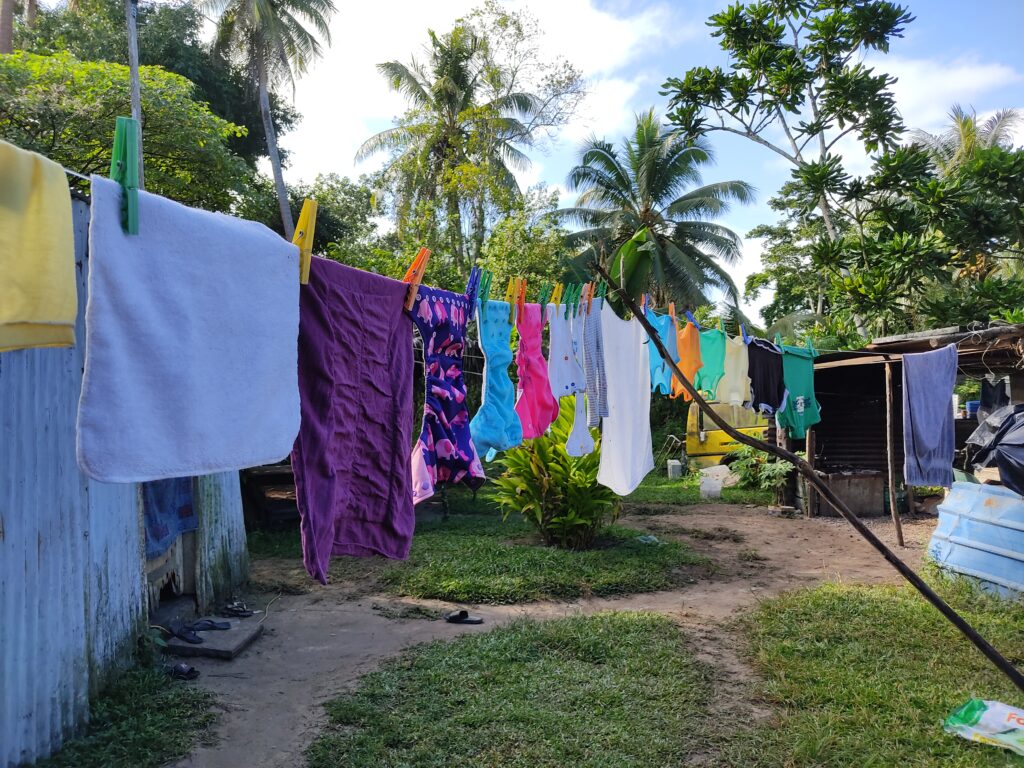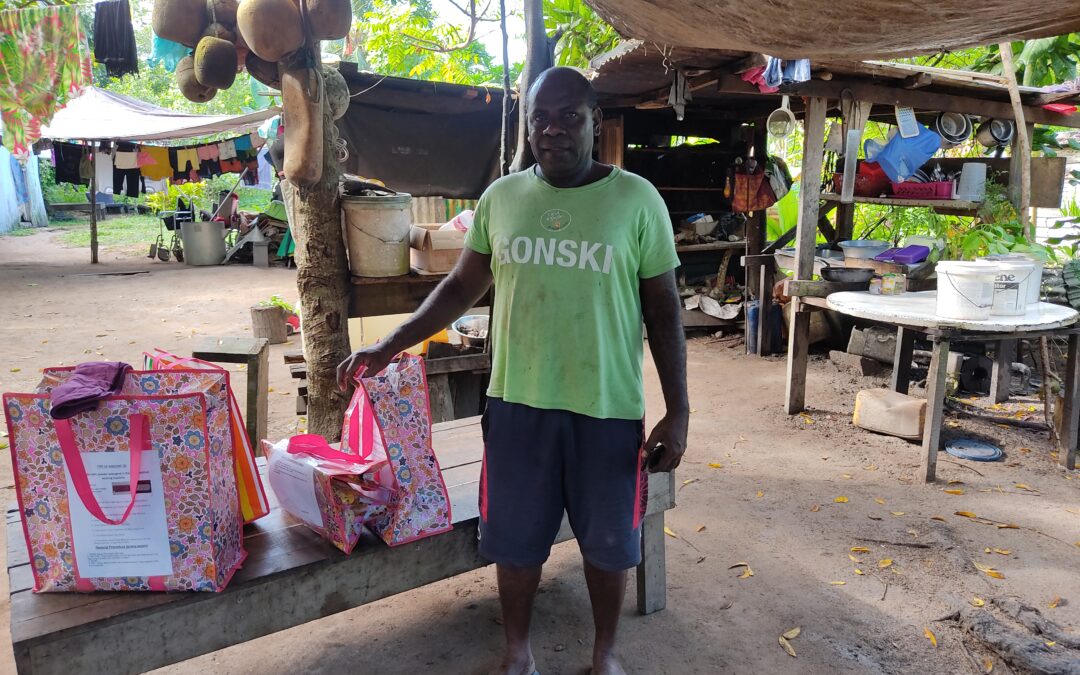Featured image: Erakor Community Facilitator
A new research report on nappy use in the Pacific has been released which provides critical insights into addressing the estimated 815 million single-use nappies used and disposed of in the Pacific region each year. EWB Australia completed the social and technical components of the research with the support of partner organisations and communities. The report was commissioned by the Secretariat of the Pacific Regional Environment Programme and funded by the European Union as part of the PacWasterPlus program – an initiative that is aiming to sustainably and cost effectively improve regional management of waste and pollution. Here are the key take-outs from the report.
The problem
The transition to a more convenient lifestyle over the last seventy years has seen a dramatic increase in single-use plastic items onto global markets (UNEP, 2018). Included in the range of items are single-use disposable nappies. Although convenient in their use, their disposal is difficult to manage and has significant impacts on our environment (UNEP, 2021). Global estimates on the number of single-use disposable nappies used on one baby ranges from 4,000 to 7,000, with each nappy reported to take nearly 500 years to decompose (Miller-Wilson, 2021; Dyer, 2005; Khoo et al., 2019).
The Pacific region has not been excluded from the increasing presence of single-use disposable nappies. An estimated 815,500,000 single-use disposable nappies are used by families in the Pacific every year , resulting in approximately 173,000 tonnes of waste disposed of in landfills, burnt, or discarded in the environment.
The purpose of the study
Single-use disposable nappies have been identified as a waste issue in Pacific countries, both in landfills and as a commonly littered item. Three Pacific countries (Kiribati, Vanuatu, and Tuvalu) have implemented import controls to assist with the management of single-use disposable nappies, the only known measures of their kind in the world. However, the need to contain and manage baby excreta to reduce public health risks is well understood, as is the need for economic growth and equality and inclusion in today’s Pacific societies, ensuring women are encouraged into the workforce and to contribute to community activities.
This research was focused on the Pacific region (add included Timor-Leste) and sought to explore current practices and perceptions on the use and disposal of single-use disposable nappies, reusable nappies, and eco-friendly or compostable nappies. It also sought to identify and understand barriers and opportunities for reducing the environmental impacts associated with single-use disposable nappy disposal in Pacific communities, balancing social and economic factors.
The findings
Several technical, social and availability barriers were identified that are preventing the adoption of alternatives to single-use disposable nappies. These include:
Lack of infrastructure for reusable nappy management
Access to water is a key challenge. There are no known designated soak-away systems for nappy wastewater in communities – common sites for washing reusable nappies are buckets, using sea water, groundwater and tank water, and most households share their water and toilet facilities with other households.
A perception that reusable nappies are difficult to use in and don’t perform well
Most households use disposable nappies because they are easy and convenient, and being at work for long periods as well as long drying times were cited as reasons for avoiding the use of reusables.
Overstated eco-credential of reusables
No 100% compostable nappies were found to be available for the Pacific countries, and consumers are unclear on claims of ecofriendliness and composability claims. There is also a lack of collection and compost infrastructure.
Low-socio economic perceptions
Using reusable nappies is seen as a sign of poverty, of being from a less developed area/community, and that families are unable to afford to buy disposable diapers. Many see using reusable nappies as a move ‘backwards’ as the rest of the world benefits from the convenience of disposable nappies.
Lack of affordability perceptions
There were varying perspectives of affordability of reusable nappies, with a common perception that reusable nappies are a sign of poverty; however others feel they are expensive, with expensive upfront costs and a lack of funds to pay for ongoing cleaning products.
Limited support for parents
Using reusable nappies takes time away from working opportunities and other community activities.
Lack of education and awareness of use and benefits
‘Experts’ currently delivering community education have a low level of knowledge of use and benefits of reusable nappies, and there was minimal awareness raising conducted by governments.
Limited availability of quality reusable products in rural areas
Low stock and low quality impacted the user experience – often multiple reusable nappies need to be used at the one time which increased the cost.
The opportunities

Reusable nappies hanging on a clothesline in Erakor, Vanuatu.
Policy controls, infrastructure improvements, and increased communication were identified as key opportunities for Pacific decision makers to assist with the management of single-use disposable nappies and the adoption of reusable nappies.
- Communication: providing information on locally appropriate methods for disposal and management of nappies
- Education and awareness: raising messages to assist communities to understand opportunities to improve management of single-use disposable diapers and adoption of reusable nappies
- Policy opportunities: for controlling the use and disposal of diapers and nappies using importation restrictions and controls; and for controlling the use and disposal of diapers and nappies using subsidies and incentives
- Private Sector: opportunities to encourage entrepreneurship activities to provide services for management of nappies and diapers
- Infrastructure: opportunities for improvements to infrastructure and services to assist with environmentally sound management of nappies and diapers
Importantly, there is no ‘one size fits all’ fix, and, as such, opportunities and design solutions need to be appropriate for communities in consultation with stakeholders – including parents, church and community groups, village Chiefs, local businesses, healthcare professionals, educators, waste managers, etc.
The full report, available here, outlines in further detail the range of opportunities to address this challenge. It is a fantastic piece of work with a huge amount of valuable information which will guide EWB’s work in this area in the future. This includes the tumble-drum project, currently underway, that is trialling solutions to reusable nappy washing – a non-electric washing machine that takes into consideration the inconsistent power supply experienced by remote communities, and optimal water efficiency.


